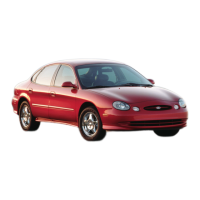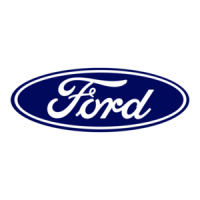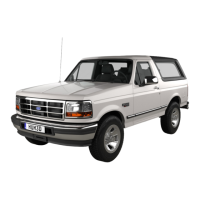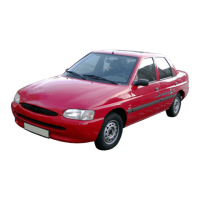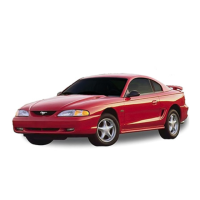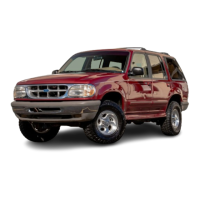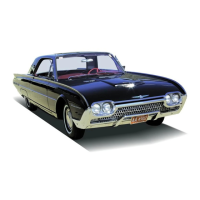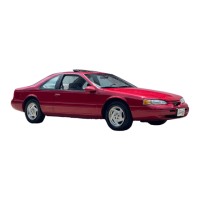
Do you have a question about the Ford 1996 Thunderbird and is the answer not in the manual?
| Brand | Ford |
|---|---|
| Model | 1996 Thunderbird |
| Category | Automobile |
| Language | English |
Explains the guide's purpose, notes, warnings, and how to find information quickly.
Details the initial 1000 miles, including brake and engine break-in procedures.
Covers washing, polishing, and cleaning specific parts like chrome and plastic.
Explains correct safety belt usage for optimal restraint and lists key positions for safety.
Describes how lap and shoulder belts adjust and lock for safety during movement.
Provides guidelines for using child safety seats and safety belts for children.
Explains the different key positions (ACC, LOCK, OFF, ON, START) and their functions.
Outlines essential steps before starting the engine, including seatbelt use and checks.
Provides detailed instructions for starting the engine in various conditions (cold, warm).
Describes warning lights and gauges on the main instrument panel for vehicle status.
Explains the meaning of the brake warning light (parking brake or fluid level).
Explains the air bag system's readiness indicator and troubleshooting.
Details the check engine light function and potential causes like emission system issues.
Details operation of fan, temperature, and mode controls for heating and defrosting.
Explains SATC system characteristics and digital display controls.
Describes how to operate turn signals, high beams, and wipers using the steering column lever.
Explains how to use wipers and washer fluid for windshield cleaning.
Covers anti-theft lock knobs and power door lock operation.
Explains locking/unlocking doors, opening trunk, and activating panic alarm via remote.
Covers opening, closing, tilting, and sliding shade operation.
Explains the function and proper positioning of head restraints.
Details how to adjust seat forward/backward and recline the seatback.
Describes how to adjust power seats in various directions.
Explains how to adjust side mirrors using the driver's door controls.
Lists glove compartment and map pockets as storage options.
Details manual trunk opening and closing procedures.
Explains remote trunk operation via the console armrest.
Covers radio operation, volume, tuning, and CD player functions.
Explains manual tuning, SEEK, SCAN, and memory preset functions.
Details radio operation, volume, tuning, and cassette player functions.
Explains AMS, SEEK, SCAN, and memory preset functions for radio tuning.
Covers radio operation, volume, tuning, and cassette player functions.
Explains AMS, SEEK, SCAN, and memory preset functions for radio tuning.
States the warranty period for the sound system.
Recommends returning to dealer for service and mentions the nationwide network.
Explains the operation of the automatic overdrive transmission.
Details how to shift gears, including the brake-shift interlock feature.
Explains when to use overdrive and the effect of the TCS switch.
Describes brake application techniques for non-ABS and ABS systems.
Explains how to set and release the parking brake.
Offers specific precautions for driving on slippery roads.
Details weight limits (GVWR, GAWR) and their impact on the vehicle.
Outlines precautions and requirements for safely towing a trailer.
Provides safety warnings and instructions for jump-starting a vehicle.
Outlines steps for preparing vehicles before connecting jumper cables.
Explains the use and limitations of the temporary spare tire.
Details safety precautions and steps before changing a tire.
Explains the 24-hour roadside assistance program and its coverage.
Guides on seeking service from dealerships and Ford Customer Assistance.
Advises on addressing satisfaction issues with dealership service.
Instructs on reporting safety defects to NHTSA and Ford.
Lists available Ford accessories and their warranty.
Highlights accessory categories like travel, comfort, and protection.
Explains Ford's approach to making vehicle servicing simple and accessible.
Lists general safety precautions for working on the vehicle.
Identifies engine types and points to diagrams for service items.
Details the process for opening the fuel filler door and filling the tank.
Recommends unleaded fuel and discusses MMT and reformulated gasolines.
Specifies recommended oil types, viscosity, and API certification.
Guides on checking oil level using the dipstick and adding oil.
Details checking coolant level, its function, and additives.
Discusses battery types, electrolyte level checks, and environmental recycling.
Covers checking washer fluid level and inspecting/cleaning wiper blades.
Emphasizes tire pressure, load limits, distribution, and safe speeds.
Explains treadwear, traction, and temperature grades for tires.
Explains checking and adding transmission fluid, including type and level.
Details checking brake fluid level and the importance of using correct DOT 3 fluid.
Guides on checking and adding power steering fluid for different engine types.
Lists fuses, their amperage rating, and the electrical components they protect.
Provides steps for locating, checking, and replacing fuses.
Suggests checking operation of various lights and headlamp alignment.
Details careful handling of halogen bulbs and replacement procedure.
Explains the OBD II system and the requirements for I/M readiness testing.
Outlines the specific driving steps required to set the OBD II system to a ready state.
Lists recommended Motorcraft parts for spark plugs, filters, and batteries.
Provides a table of Ford part numbers and specifications for various fluids and lubricants.
Offers general recommendations for storing a vehicle for extended periods.
Advises on filling the fuel tank and the effects of fuel deterioration during storage.
Advises on checking, recharging, and disconnecting the battery.
Emphasizes tire pressure, load limits, distribution, and safe speeds.
